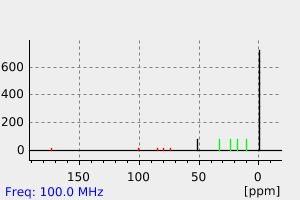methyl 9-trimethylsilyl nona-5,8-diynoate | 105198-73-0
中文名称
——
中文别名
——
英文名称
methyl 9-trimethylsilyl nona-5,8-diynoate
英文别名
Hpudprfcrxvfpg-uhfffaoysa-;methyl 9-trimethylsilylnona-5,8-diynoate
CAS
105198-73-0
化学式
C13H20O2Si
mdl
——
分子量
236.386
InChiKey
HPUDPRFCRXVFPG-UHFFFAOYSA-N
BEILSTEIN
——
EINECS
——
-
物化性质
-
计算性质
-
ADMET
-
安全信息
-
SDS
-
制备方法与用途
-
上下游信息
-
文献信息
-
表征谱图
-
同类化合物
-
相关功能分类
-
相关结构分类
计算性质
-
辛醇/水分配系数(LogP):2.6
-
重原子数:16
-
可旋转键数:5
-
环数:0.0
-
sp3杂化的碳原子比例:0.62
-
拓扑面积:26.3
-
氢给体数:0
-
氢受体数:2
上下游信息
反应信息
-
作为反应物:描述:methyl 9-trimethylsilyl nona-5,8-diynoate 在 Lindlar's catalyst 、 copper(l) iodide 、 四(三苯基膦)钯 、 对甲苯磺酸 喹啉 、 正丙胺 、 lithium hydroxide 、 四丁基氟化铵 、 氢气 作用下, 以 四氢呋喃 、 乙醇 、 正己烷 、 水 、 苯 为溶剂, 25.0~45.0 ℃ 、101.33 kPa 条件下, 反应 1.5h, 生成 12(S-羟基(5Z,8Z,10E,14Z-二十四碳四烯酸参考文献:名称:A General Strategy for the Synthesis of Monohydroxy-eicosatetraenoic Acids: Total Synthesis of 5(S)-Hydroxy-6(E),8,11,14(Z)-eicosatetraenoic Acid (5-HETE) and 12(S)-Hydroxy-5,8,14(Z), 10(E)-eicosatetraenoic Acid (12-HETE)摘要:通过钯(0)-铜(I)耦合技术合成5(S)-羟基-6(E),8, 11,14(Z)-二十碳四烯酸(5-HETE)和12(S)-羟基-5,8,14(Z), 10(E)-二十碳四烯酸(12-HETE)的立体选择性全合成过程被描述。DOI:10.1055/s-1986-31612
-
作为产物:描述:3-(trimethylsilyl)prop-2-ynyl tosylate 、 6,6,6-trimethoxy-1-hexyne 在 乙基溴化镁 、 copper(I) bromide 作用下, 生成 methyl 9-trimethylsilyl nona-5,8-diynoate参考文献:名称:A General Strategy for the Synthesis of Monohydroxy-eicosatetraenoic Acids: Total Synthesis of 5(S)-Hydroxy-6(E),8,11,14(Z)-eicosatetraenoic Acid (5-HETE) and 12(S)-Hydroxy-5,8,14(Z), 10(E)-eicosatetraenoic Acid (12-HETE)摘要:通过钯(0)-铜(I)耦合技术合成5(S)-羟基-6(E),8, 11,14(Z)-二十碳四烯酸(5-HETE)和12(S)-羟基-5,8,14(Z), 10(E)-二十碳四烯酸(12-HETE)的立体选择性全合成过程被描述。DOI:10.1055/s-1986-31612
文献信息
-
An efficient stereocontrolled synthesis of 12(R)-HETE and 12(S)-HETE作者:Denis Chemin、Sylvie Gueugnot、Gérard LinstrumelleDOI:10.1016/s0040-4020(01)80446-4日期:1992.1An efficient synthesis of 12(R) and 12(S) HETEs was realized by assembly of the easily obtainable synthons: optically pure iodo-alcohols 3(R) and 3(S) with the ester 4, followed by reduction with activated zinc.
-
Synthesis and Functional Assessment of a Novel Fatty Acid Probe, ω-Ethynyl Eicosapentaenoic Acid Analog, to Analyze the in Vivo Behavior of Eicosapentaenoic Acid作者:Tomohisa Tokunaga、Bunta Watanabe、Sho Sato、Jun Kawamoto、Tatsuo KuriharaDOI:10.1021/acs.bioconjchem.7b00235日期:2017.8.16Eicosapentaenoic acid (EPA) is an ω-3 polyunsaturated fatty acid that plays various beneficial roles in organisms from bacteria to humans. Although its beneficial physiological functions are well-recognized, a molecular probe that enables the monitoring of its in vivo behavior without abolishing its native functions has not yet been developed. Here, we designed and synthesized an ω-ethynyl EPA analog (eEPA) as a tool for analyzing the in vivo behavior and function of EPA. eEPA has an ω-ethynyl group tag in place of the ω-methyl group of EPA. An ethynyl group has a characteristic Raman signal and can be visualized by Raman scattering microscopy. Moreover, this group can specifically react in situ with azide compounds, such as those with fluorescent group, via click chemistry. In this study, we first synthesized eEPA efficiently based on the following well-known strategies. To introduce four C–C double bonds, a coupling reaction between terminal acetylene and propargylic halide or tosylate was employed, and then, by simultaneous and stereoselective partial hydrogenation with P-2 nickel, the triple bonds were converted to cis double bonds. One double bond and an ω-terminal C–C triple bond were introduced by Wittig reaction with a phosphonium salt harboring an ethynyl group. Then, we evaluated the in vivo function of the resulting probe by using an EPA-producing bacterium, Shewanella livingstonensis Ac10. This cold-adapted bacterium inducibly produces EPA at low temperatures, and the EPA-deficient mutant (ΔEPA) shows growth retardation and abnormal morphology at low temperatures. When eEPA was exogenously supplemented to ΔEPA, eEPA was incorporated into the membrane phospholipids as an acyl chain, and the amount of eEPA was about 5% of the total fatty acids in the membrane, which is comparable to the amount of EPA in the membrane of the parent strain. Notably, by supplementation with eEPA, the growth retardation and abnormal morphology of ΔEPA were almost completely suppressed. These results indicated that eEPA mimics EPA well and is useful for analyzing the in vivo behavior of EPA.二十碳五烯酸(EPA)是一种ω-3 多不饱和脂肪酸,在从细菌到人类的各种生物体内发挥着各种有益的作用。尽管其有益的生理功能已得到广泛认可,但目前尚未开发出一种分子探针,可在不破坏其原生功能的情况下监测其体内行为。在这里,我们设计并合成了一种ω-乙炔基 EPA 类似物(eEPA),作为分析 EPA 体内行为和功能的工具。乙炔基具有特征性的拉曼信号,可通过拉曼散射显微镜观察到。此外,该基团还能通过点击化学与叠氮化物(如带有荧光基团的叠氮化物)发生特异性原位反应。在本研究中,我们首先基于以下众所周知的策略高效合成了 eEPA。为了引入四个 C-C 双键,我们采用了末端乙炔与丙炔卤化物或甲苯磺酸盐之间的偶联反应,然后通过与 P-2 镍同时进行立体选择性部分氢化,将三键转化为顺式双键。通过与含有乙炔基的鏻盐进行维蒂希反应,引入了一个双键和一个ω-末端的 C-C 三键。然后,我们利用一种生产 EPA 的细菌 Shewanella livingstonensis Ac10 评估了所生成探针的体内功能。这种适应低温的细菌在低温条件下会诱导产生 EPA,而 EPA 缺失突变体(ΔEPA)在低温条件下会出现生长迟缓和形态异常。当向ΔEPA外源补充eEPA时,eEPA以酰基链的形式结合到膜磷脂中,eEPA的含量约占膜中脂肪酸总量的5%,与亲本菌株膜中EPA的含量相当。值得注意的是,通过补充 eEPA,ΔEPA 的生长迟缓和异常形态几乎被完全抑制。这些结果表明,eEPA 能很好地模拟 EPA,可用于分析 EPA 在体内的行为。
-
An efficient route to skipped diynes and triynes, (Z,Z) dienes and (Z,Z,Z) trienes.作者:Tuyêt Jeffery、Sylvie Gueugnot、Gérard LinstrumelleDOI:10.1016/0040-4039(92)89024-7日期:1992.9Skipped triynes and (Z,Z,Z) trienes have also been successfully prepared.速滑的三炔和(Z,Z,Z)三烯也已成功制备。
-
Lapitskaya; Vasiljeva; Pivnitsky, Synthesis, 1993, # 1, p. 65 - 66作者:Lapitskaya、Vasiljeva、PivnitskyDOI:——日期:——
-
Synthesis of methyl (5Z,8Z,10E,12E,14Z)-eicosapentaenoate作者:Yasser M.A. Mohamed、Trond Vidar HansenDOI:10.1016/j.tetlet.2010.12.078日期:2011.3The first total synthesis of methyl (5Z,8Z,10E,12E,14Z)-eicosapentaenoate has been achieved in seven steps and in 16% overall yield. The synthesis confirmed the assigned structure of this polyunsaturated natural product. (C) 2010 Elsevier Ltd. All rights reserved.
表征谱图
-
氢谱1HNMR
-
质谱MS
-
碳谱13CNMR
-
红外IR
-
拉曼Raman
-
峰位数据
-
峰位匹配
-
表征信息
同类化合物
(±)17,18-二HETE
(±)-辛酰肉碱氯化物
(Z)-5-辛烯甲酯
(Z)-4-辛烯酸
(R)-甲羟戊酸锂盐
(R)-普鲁前列素,游离酸
(R,R)-半乳糖苷
(E)-4-庚烯酸
(E)-4-壬烯酸
(E)-4-十一烯酸
(9Z,12E)-十八烷二烯酸甲酯
(6E)-8-甲基--6-壬烯酸甲基酯-d3
(3R,6S)-rel-8-[2-(3-呋喃基)-1,3-二氧戊环-2-基]-3-羟基-2,6-二甲基-4-辛酮
龙胆二糖
黑曲霉二糖
黄质霉素
麦芽酮糖一水合物
麦芽糖醇
麦芽糖酸
麦芽糖基蔗糖
麦芽糖一水合物
麦芽糖
鳄梨油酸乙酯
鲸蜡醇蓖麻油酸酯
鲸蜡醇油酸酯
鲸蜡硬脂醇硬脂酸酯
鲸蜡烯酸脂
鲸蜡基花生醇
鲫鱼酸
鲁比前列素
鲁比前列素
高级烷基C16-18-醇
高甲羟戊酸
高效氯氰菊酯
高-gamma-亚油酸
马来酸烯丙酯
马来酸氢异丙酯
马来酸氢异丁酯
马来酸氢丙酯
马来酸氢1-[2-(2-羟基乙氧基)乙基]酯
马来酸单乙酯
马来酸单丁酯
马来酸二辛酯
马来酸二癸酯
马来酸二甲酯
马来酸二烯丙酯
马来酸二正丙酯
马来酸二戊基酯
马来酸二异壬酯
马来酸二异丙酯







